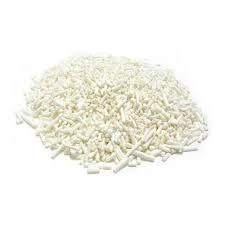
formaldehyde to formic acid
The Transformation of Formaldehyde to Formic Acid A Chemical Perspective
Formaldehyde is a simple organic compound with the chemical formula CH₂O. It is a colorless gas with a pungent odor, commonly used in various industrial applications, including the production of plastics, textiles, and as a disinfectant. Conversely, formic acid, known chemically as HCOOH, is a carboxylic acid that occurs naturally in the venom of ants and in many plants. The transformation of formaldehyde into formic acid is an important chemical reaction with significant implications in both industrial applications and biological systems.
Mechanism of the Transformation
The conversion of formaldehyde to formic acid can occur through two main pathways oxidation and hydrolysis. In typical conditions, formaldehyde is oxidized to formic acid through a series of chemical reactions. The oxidation process involves the addition of oxygen and the removal of hydrogen from the formaldehyde molecule. This process can be catalyzed using various oxidizing agents, such as potassium permanganate (KMnO₄) or silver oxide (Ag₂O).
In the case of hydrolysis, formaldehyde can react with water in the presence of acids or bases, which facilitates the formation of methylene glycol (CH₂(OH)₂) that can further decompose or oxidize to produce formic acid. This pathway highlights the importance of water in the chemical environment, as it serves not only as a solvent but also as a reactant that plays a critical role in the conversion process.
Industrial Relevance
The ability to convert formaldehyde into formic acid is of great interest in various industrial fields. Formic acid is used extensively as a preservative, a coagulant in rubber production, and an intermediate in the synthesis of several chemical compounds. Additionally, formic acid acts as a reducing agent in various chemical processes, making it valuable for pharmaceutical manufacturing and the production of more complex organic molecules.
The direct synthesis of formic acid from formaldehyde offers a potentially economical and efficient route for industries looking to produce formic acid in large quantities. The process can be integrated into existing formaldehyde production facilities, minimizing the need for additional raw materials and reducing overall production costs.
formaldehyde to formic acid

Environmental Considerations
Formaldehyde is known for its toxicity and potential health hazards, emphasizing the need for safe handling and disposal methods. The transformation of formaldehyde into less toxic derivatives such as formic acid can be seen as a step towards reducing environmental and health risks associated with formaldehyde exposure. Furthermore, formic acid itself can be biodegradable and may serve as an environmentally friendly alternative to various industrial solvents and reagents.
Efforts to develop green chemistry practices are increasingly focusing on transforming hazardous chemicals into safer substances. The oxidation of formaldehyde to formic acid exemplifies such efforts, demonstrating the potential for sustainable chemical manufacturing processes.
Biological Implications
The conversion of formaldehyde into formic acid also has biological significance. In nature, certain bacteria and microorganisms possess the ability to metabolize formaldehyde, converting it into formic acid as a means of energy production. This metabolic pathway is essential for the detoxification of formaldehyde, which can be harmful at elevated concentrations.
In more recent studies, researchers have explored the potential of utilizing engineered microorganisms to enhance the efficiency of this transformation, opening avenues for biotechnology applications. By harnessing microbial processes that convert formaldehyde into formic acid, there may be potential benefits for waste treatment and bioremediation efforts.
Conclusion
The transformation of formaldehyde to formic acid encompasses a complex interplay of chemical reactions with numerous implications in industrial, environmental, and biological contexts. This conversion presents opportunities for developing safer production processes, creating useful chemical intermediates, and mitigating the health risks associated with formaldehyde. As research continues to explore innovative methods for this transformation and its applications, the potential for sustainable and eco-friendly practices in the chemical industry remains a promising frontier. The relationship between these two compounds underscores the importance of understanding chemical processes, paving the way for future advancements in both science and technology.
-
Sodium Dichloroisocyanurate Safety Handling ProtocolsNewsJul.29,2025
-
Mining Chemicals for Copper Extraction Processes GuideNewsJul.29,2025
-
Fertilizer for Sale Shipping and Storage TipsNewsJul.29,2025
-
Dimethyl Disulfide as Sulfurizing AgentNewsJul.29,2025
-
Benzotriazole Safety Data Handling and Storage GuidelinesNewsJul.29,2025
-
Ammonium Bicarbonate Safety Handling Storage GuidelinesNewsJul.29,2025
-
The Transformative Role Of Trichloroisocyanuric Acid in Water TreatmentNewsJul.23,2025
Hebei Tenger Chemical Technology Co., Ltd. focuses on the chemical industry and is committed to the export service of chemical raw materials.
-

view more DiethanolisopropanolamineIn the ever-growing field of chemical solutions, diethanolisopropanolamine (DEIPA) stands out as a versatile and important compound. Due to its unique chemical structure and properties, DEIPA is of interest to various industries including construction, personal care, and agriculture. -

view more TriisopropanolamineTriisopropanolamine (TIPA) alkanol amine substance, is a kind of alcohol amine compound with amino and alcohol hydroxyl, and because of its molecules contains both amino and hydroxyl. -

view more Tetramethyl Thiuram DisulfideTetramethyl thiuram disulfide, also known as TMTD, is a white to light-yellow powder with a distinct sulfur-like odor. It is soluble in organic solvents such as benzene, acetone, and ethyl acetate, making it highly versatile for use in different formulations. TMTD is known for its excellent vulcanization acceleration properties, which makes it a key ingredient in the production of rubber products. Additionally, it acts as an effective fungicide and bactericide, making it valuable in agricultural applications. Its high purity and stability ensure consistent performance, making it a preferred choice for manufacturers across various industries.











